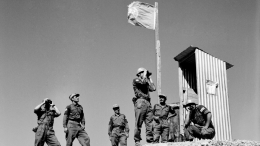The following piece by Adam Day was originally published at World Politics Review.
Does international peacekeeping protect civilians caught up in civil wars? Do the 16,000 United Nations peacekeepers deployed in the Democratic Republic of the Congo actually save lives, and if so how many? Did the 9,000 patrols conducted by the UN Mission in South Sudan in the past three months protect civilians there?
The answer is a dissatisfying “maybe.” Without a convincing story of saving lives, the UN is open to attacks by the likes of White House national security adviser John Bolton, who call peacekeeping “unproductive” and push for further cuts to the organization’s already diminished budget. But peacekeeping can — and must — make a case for its own utility, using data already at its fingertips.
Peacekeeping has proven that it can help reduce threats over time and may even help to diminish overall levels of violence in conflict-prone areas. But when confronted with the question of whether a peacekeeping operation has prevented a specific threat to civilians, most of the time the UN is unable to answer. In contrast, critics of peacekeeping can point to the numbers of people killed on the UN’s watch. The UN was “underequipped” to protect the 75 civilians killed in the Central African Republic in September 2016. The UN Mission in South Sudan “underperformed” in protecting the 37,000 residents attacked in its camp in Juba. The UN “failed to intervene” to stop a massacre of 30 people in eastern Congo. The horrors of Rwanda in 1994 loom large. The human cost is all too clear, counted in bodies, and is perversely used as further evidence that peacekeeping budgets should be cut.
What is missing is the evidence of the hundreds of times the UN acts preventively to defuse tensions, or when it receives an alert of an emerging threat and responds quickly, getting to the scene before people die. Having served in some of the biggest peacekeeping operations in the world, I have seen firsthand the many times that missions respond within minutes to alerts, often in time to prevent further atrocities. It is a recurrent frustration of peacekeeping leadership that there appears to be no quick, evidence-based way to tell these success stories.
Yet measuring and understanding the relationship between personnel deployment and outcomes is not exactly a new science. The New York Police Department started doing this almost 30 years ago, and such geospatial analysis is now cheap, easy and routine in police forces around the world. The commander of NATO forces in Afghanistan could point to a map of all troops in the country, showing how, where and when they responded to threats. Ask US Central Command where American soldiers have patrolled in Iraq and its officials can show you exactly where. It is basic military command and control, and a basic data requirement, to know where your troops are all the time — and it is how organizations justify their budgets.
But in UN peacekeeping, most of that data gets put in a filing cabinet, or at best a hard drive. Peacekeeping patrols offer the clearest example of this problem. Typically, a UN commander will issue what is called a FRAGO, or fragmentary order — a piece of paper that instructs a military or police subordinate to carry out a specific action, often a patrol. This order will contain crucial information: the composition of the patrol, the route, the time frame and the purpose. Currently, though, the order does not feed into a centralized UN peacekeeping database that can be tracked. Instead, some facts about the patrol are included in a general report produced by the UN, while the rest is often lost to the system, unless typed up on request later.
For example, after a recent three-month interval, UNAMID — the joint UN-African Union Mission in Darfur — reported that it conducted 2,667 protection patrols in Darfur, while MONUSCO, the UN peacekeeping mission in Congo, pointed to 59 standing combat deployments and 492 alerts per month as evidence of its protection impact. Did any of these patrols or deployments save lives? If the data from the fragmentary order fed a constantly updated system that showed U.N. troops arriving minutes after receiving a warning, they might be able to make a case. But as of now, we simply don’t know.
The UN’s Department of Peace Operations has taken some steps toward better use of data. The Situational Awareness Geospatial Enterprise, or SAGE, in theory has begun to allow peacekeeping to track incidents systematically and begin developing a system of data-driven protection. Other innovations, such as the Comprehensive Performance Assessment System, which is beginning to focus UN monitoring and evaluation more on impact, and other new IT platforms are gradually strengthening data collection and may eventually lead to “smart peacekeeping.” And the UN’s internal office of oversight has made efforts to track protection responses with the large amounts of data that can be extracted, with great effort, from the system. In some places, like Haiti, tech-driven peacekeeping has already shown promising results. So data can be put to work.
But if peacekeeping is to show that the billions of dollars it spends patrolling war-torn countries does, in fact, save lives, it should systematically use the cheap and easy tools at its disposal. Transitioning from a paper fragmentary order to an electronic one would be an easy and cheap first step, allowing the UN to track its patrols in real time and compare responses to incidents as they are reported. Other steps, such as GPS trackers on UN troop vehicles, would build an even more sophisticated picture of when and where the UN is acting to carry out its protection mandate. This is already being done for civilians in the UN, with the electronic movement of personnel forms and GPS trackers in civilian vehicles. It would be easy and cheap to apply these simple tools to the troops.
Using data to tell a story of peacekeeping may not be popular. Troops that do not patrol much, or that refuse to leave their barracks during an attack, will have nowhere to hide when the press — and hopefully the secretary-general — comes for them. Many troop contributors may not like the idea of being under the spotlight, but those are almost certainly the underperformers. In contrast, the thousands of peacekeepers who regularly respond to protection threats in a fast, effective manner should welcome this opportunity to showcase their work, as should the secretary-general’s Action for Peacekeeping initiative. With this minimal shift toward smart peacekeeping, the UN has an opportunity to show clearly that it does save lives.


